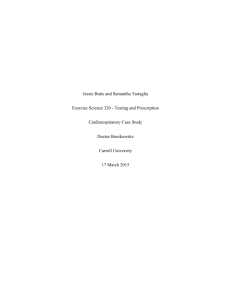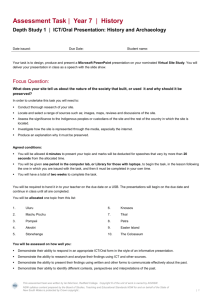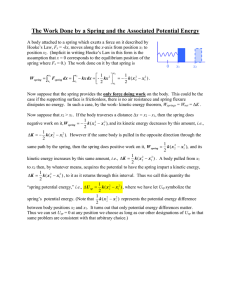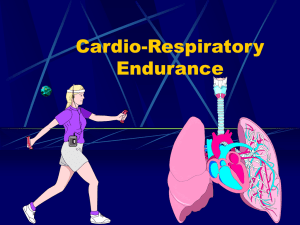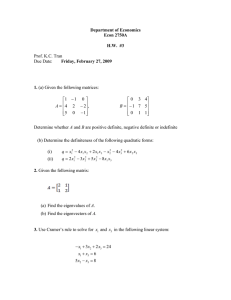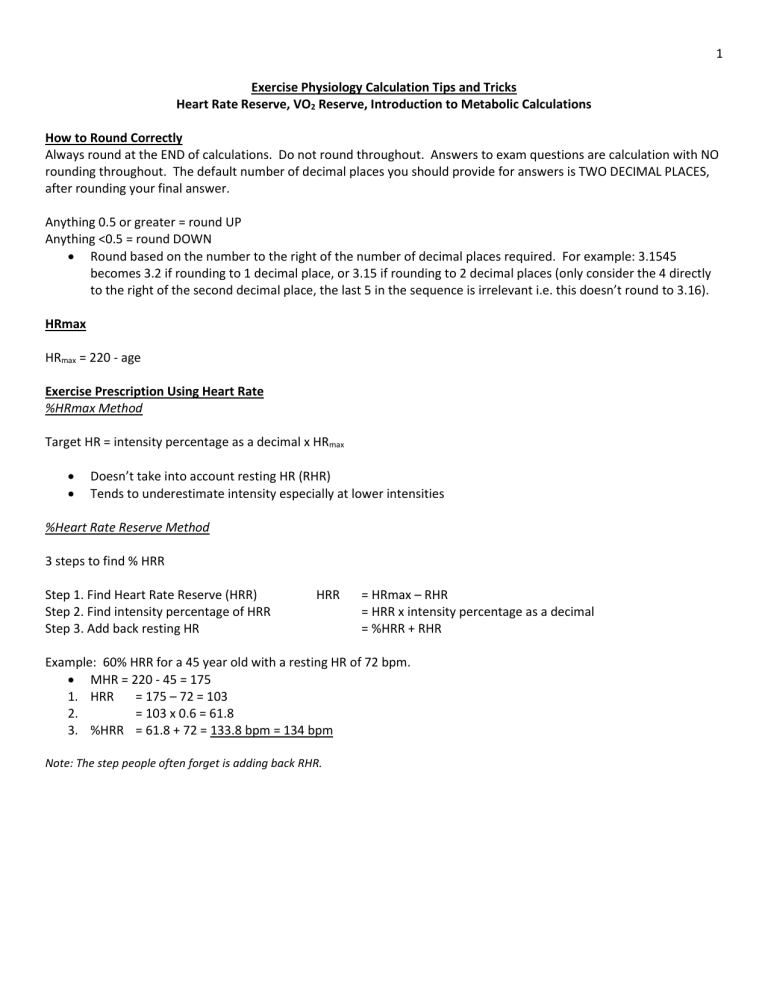
1 Exercise Physiology Calculation Tips and Tricks Heart Rate Reserve, VO2 Reserve, Introduction to Metabolic Calculations How to Round Correctly Always round at the END of calculations. Do not round throughout. Answers to exam questions are calculation with NO rounding throughout. The default number of decimal places you should provide for answers is TWO DECIMAL PLACES, after rounding your final answer. Anything 0.5 or greater = round UP Anything <0.5 = round DOWN • Round based on the number to the right of the number of decimal places required. For example: 3.1545 becomes 3.2 if rounding to 1 decimal place, or 3.15 if rounding to 2 decimal places (only consider the 4 directly to the right of the second decimal place, the last 5 in the sequence is irrelevant i.e. this doesn’t round to 3.16). HRmax HRmax = 220 - age Exercise Prescription Using Heart Rate %HRmax Method Target HR = intensity percentage as a decimal x HRmax • • Doesn’t take into account resting HR (RHR) Tends to underestimate intensity especially at lower intensities %Heart Rate Reserve Method 3 steps to find % HRR Step 1. Find Heart Rate Reserve (HRR) Step 2. Find intensity percentage of HRR Step 3. Add back resting HR HRR = HRmax – RHR = HRR x intensity percentage as a decimal = %HRR + RHR Example: 60% HRR for a 45 year old with a resting HR of 72 bpm. • MHR = 220 - 45 = 175 1. HRR = 175 – 72 = 103 2. = 103 x 0.6 = 61.8 3. %HRR = 61.8 + 72 = 133.8 bpm = 134 bpm Note: The step people often forget is adding back RHR. 2 Exercise Prescription Using VO2 %VO2max Method Target %VO2max = intensity percentage as a decimal x VO2max It used to be assumed that exercising at a certain percentage of VO2max would elicit that same percent HRR, i.e. 60% VO2max would produce a HR that was 60% HRR. This is not the case. The error between %HRR and %VO2max at rest is large, especially for less fit clients. As exercise intensity increases this error does become smaller but is still present. The error is greatest in less fit clients working at low intensities. By using VO2R or HRR estimations for intensity you can calculate an intensity that is relative to that clients own ability. %VO2 Reserve Method 3 steps to find % VO2R (exactly the same method as finding HRR) Step 1. Find VO2 Reserve (VO2R) Step 2. Find intensity percentage of VO2R Step 3. Add back resting VO2 VO2R = VO2max – RestingVO2 = VO2R x intensity percentage as a decimal = %VO2R + Resting VO2 Resting VO2 is 3.5 ml/kg/min Example: 60% VO2R for a 45 year old with a VO2max of 39 ml/kg/min. 1. VO2R = 39 – 3.5 = 35.5 2. = 35.5 x 0.6 = 21.3 3. %VO2R = 21.3 + 3.5 = 24.8 ml/kg/min Note: The step people often forget is adding back Resting VO2. Table 1. Comparison of %VO2R, %HRR, and %HRmax %VO2R %HRR %HRmax RPE 40% 40% 64% 12 50% 50% 70% 13 60% 60% 77% 14 70% 70% 84% 15 80% 80% 91% 16 85% 85% 94% 17 Note: RPE is a perceived exertion and not exactly equivalent to HR or VO 2 values. 3 1. What is the target HRR for a 56 year old woman with a resting HR of 75 bpm exercising at 50% HRR? 2. What is the target HRR for a 31 year old with a resting HR of 52 bpm exercising at 65% HRR? 3. What is the target HRR for a 42 year old with a resting HR of 54 exercising at 85% HRR? 4. What is the 40-60% HRR range for a 50 year old with a resting HR of 65 bpm? 5. You want your 27 year old client to run at a HRR of 80-85%. His resting HR is 51 bpm. What is the HR range? 6. You would like your 65 year old client to exercise at 45-55% HRR. Her resting HR is 65 bpm. What is the HR range? 7. You want your 72 year old client to exercise at 40-50% HRR. His resting HR is 80 bpm. What is the HR range? 4 8. Your clients predicted VO2max is 42 ml/kg/min. What is 60% VO2R? 9. Your clients predicted VO2max is 36 ml/kg/min. What is 55% VO2R? 10. Your clients predicted VO2max is 55 ml/kg/min. What is the 40 - 60% VO2R range? 11. Your clients predicted VO2max is 39 ml/kg/min. What is the 80 - 85% VO2R range? 12. Your clients predicted VO2max is 62 ml/kg/min. What is the 90 - 95% VO2R range? 13. Your clients predicted VO2max is 46 ml/kg/min. What is the 60 - 70% VO2R range? 14. Your clients predicted VO2max is 32 ml/kg/min. What is the 55 - 65% VO2R range? 5 ACSM Metabolic Calculations Walking VO2 (ml/kg/min) = (0.1 x S) + (1.8 x S x G) + 3.5 Treadmill/Outdoor Running VO2 (ml/kg/min) = (0.2 x S) + (0.9 x S x G) + 3.5 Leg Ergometry VO2 (ml/kg/min) = ((1.8 x work rate (in kgm/min))/M) + 3.5 + 3.5 Arm Ergometry VO2 (ml/kg/min) = (3 x work rate (in kgm/min)/M) + 3.5 Stepping VO2 (ml/kg/min) = (0.2 x f) + (1.33 x 1.8 x H x f) + 3.5 Where: S = Speed in m/min G = Grade is percent grade expressed in decimal format (e.g. 10% = 10/100 = 0.10) H = Step height in m f = Step frequency in steps per min M = Body mass in kg Note: These calculations will be given to you in exams and on the ACSM EPC exam. You don’t need to memorize these equations but you DO need to know how to use them (e.g. you need to know that S = Speed and that speed is in m/min). Conversions will not be given to you. For ALL equations: • ACSM equations ALWAYS give a result in relative units (ml/kg/min). Typically, relative VO2s will be in double digits. Absolute VO2 (L/min) will ALWAYS be in single digits or a 0.something number. In general, if you get an answer for any of these equations that is not double digits you’ve done the calculation incorrectly. • Resting VO2 is 3.5 ml/kg/min. That is the +3.5 you see at the end of these equations. You will only ever see single digit answers for these equations for resting data or EXTREMELY low intensity/deconditioned examples. Look at the question details to determine if this is the case. If your example client is jogging and your answer is 9.5 ml/kg/min, you’ve done something wrong. • All units in these equations are in METRIC. Learn your conversions. • Units are always important. Keep track of your units. • Learn what is a reasonable number for VO2, kcal, workload etc… if you have to do an extra calculation to get a number into something you are familiar with, do it. If a number looks wrong, it probably is. • Gross vs net – Gross includes resting VO2, net subtracts out resting VO2. Think of it as gross is before taxes, net is after taxes, and the taxes are resting VO2. For the walking and running/jogging equations: • Speed is ALWAYS in meters per minute (m/min). • 1 mph = 26.8 m/min. For example 3.5 mph = 3.5 x 26.8 = 93.8 m/min • If you use mph in the equations you will get a single digit answer. This answer is NOT L/min, you have done the equation incorrectly if you get a single digit answer for any exercise calculation. • Grade is used as a decimal. For example a 5% grade is 5/100 = 0.05. If you use a whole number you will get a ridiculous result. • When there is no grade given the grade = 0%. This will cancel out this parenthetical expression. Example 1: Jogging calculation What is the oxygen cost (VO2) of a 65 kg person running at 6.7 mph on a 2% grade? VO2 (ml/kg/min) = (0.2 x S) + (0.9 x S x G) + 3.5 = (0.2 x (6.7 x 26.8)) + (0.9 x (6.7 x 26.8) x (2/100)) + 3,5 = 35.912 + 3.23208 + 3.5 = 42.64408 round to 2 decimal places = 42.64 ml/kg/min (units are always important) 6 For the arm/leg ergometry equations: • Work rate is ALWAYS in kgm/min (kilogram meters per minute). • Sometimes you will need to calculate workrate from a given resistance. This calculation is: o Work (kgm/min) = resistance in kg x rpm x flywheel distance ▪ Flywheel distance for a monark cycle ergometer = 6 m (learn this) ▪ Flywheel distance for a monark arm ergometer = 2.4 m (learn this) o This calculation and these distances will NOT be given to you in exams. o You will sometimes see resistance in kg called kp – kilopond. These are interchangeable. Kg ≡ Kp • Most fitness equipment uses Watts for workload. o 1 Watt = 6.12 kgm/min, example 100 W = 612 kgm/min • Body mass is in kg. 1 kg = 2.2 lb. • ALWAYS complete the workrate/body mass expression first, hit =, THEN add the 3.5 or 7 to the answer. If you add 3.5 or 7 to the body mass and use this as your denominator you will get an incorrect answer. It will be close but it will be incorrect. ACSM will include this answer as an option on the EP-C exam. Example 2: cycling calculation What is the oxygen cost (VO2) of a 65 kg person cycling at 50 rpm at 125W? VO2 (ml/kg/min) = ((1.8 x work rate (in kgm/min))/M) + 3.5 + 3.5 = (1.8 x (125 x 6.12))/65 + 7 = 21.18 + 7 = 28.18 ml/kg min Example 3: What would be the resistance applied on a Monark cycle ergometer? • Work (kgm/min) = resistance in kg x rpm x flywheel distance Work = 125W x 6.12 = 765 kgm/min, Flywheel distance = 6 m, cadence = 50 rpm. 765 kgm/min = resistance x 6 m x 50 rpm (simplify) 765 kgm/min = resistance x 300 (divide both sides by 300) 2.55 kg = resistance applied For the stepping equation: • Frequency is in steps per minute. • Step height is in meters (m) o 1 inch = 2.54 cm o 100 cm = 1 m o 1 inch = 0.0254 m Example 4: stepping calculation What is the oxygen cost (VO2) of stepping on a 12 inch bench at a rate of 20 steps per minute? VO2 (ml/kg/min) = (0.2 x f) + (1.33 x 1.8 x H x f) + 3.5 = (0.2 x 20) + (1.33 x 1.8 x (12 x 0.0254) x 20) + 3.5 = (4) + (14.593824) + 3.5 = 22.093824 ml/kg/min – round to 2 decimal places = 22.09 ml/kg/min 7 Solving for unknowns: • Step 1: What is the question asking for? What equation/equations do you need? • Step 2: Fill in what you know. Sometimes you will need to do further calculations to find workloads or other variables in the correct units. • Step 3: Start simplifying and using algebra to solve for the unknown. • Remember, + and – go together, and x and ÷ go together. If something is added at the end of an equation it needs to be subtracted from both sides to get rid of it. If something is multiplied by a constant then both sides need to be divided by that constant to get rid of it. Example 5: How fast would the runner from the first example calculation need to be running to attain the same VO2 on a flat (0%) grade? Step 1: Equation = VO2 (ml/kg/min) = (0.2 x S) + (0.9 x S x G) + 3.5 Step 2: What do we know? = 42.64 = (0.2x S) + ((0.9 x S x 0) + 3.5 Step 3: Solve for the unknown (speed). Subtract 3.5 from both sides = 39.14 = (0.2x S) + ((0.9 x S x 0) Cancel out the second parenthetical expression (has a 0 in it) = 39.14 = (0.2x S) Divide both sides by 0.2 = 195.7 = Speed Is this 195.7 mph? NO! Transform speed in m/min to mph = 195.7/26.8 = 7.3 mph The runner would need to run at 7.3 mph to be using the same amount of O2 if running on the flat. OR the runner would need to be running at 7.3 mph to be running at the same %VO2max on a level surface (this is the more common use of these calculations since many prescriptions are % of max). Important conversions/units/constants for the ACSM equations (learn these) • Speed in m/min 1 mph = 26.8 m/min • Grade as a decimal e.g. 10% = 0.1 • Body weight always in kg 1 kg = 2.2 lb • Workrate on ergs in kgm/min 1 Watt = 6.12 kgm/min • Work (kgm/min) = resistance in kg x rpm x flywheel distance o Monark cycle ergometer flywheel distance = 6 m o Monark arm ergometer flywheel distance = 2.4 m • Kp and kg are the same thing • Step height is in m 1 inch = 0.0254 m • 1 MET = 3.5 ml/kg/min (calculating workload based on METs is common in cardiac rehab) • 1 L/min VO2 burns 5 kcal/min o You must convert relative VO2 into absolute VO2 to figure out calorie burning. There is no shortcut. Absolute and relative conversions Absolute to relative (L/min → ml/kg/min) = (L/min x 1000)/body weight (kg) Relative to absolute (ml/kg/min → L/min) = (ml/kg/min/1000) x body weight (kg) Why is it important to know this? - We know that %VO2R and %HRR are essentially equivalent. If you want your client to exercise at a certain percentage of their HRR or VO2R you will be able to target a workload or speed immediately without having to try out a number of different workloads before getting to the right one. This is essential for a professional and accurate training session (i.e. you will look like you know what you’re doing!).
